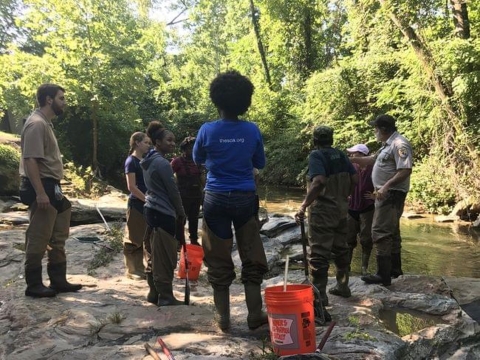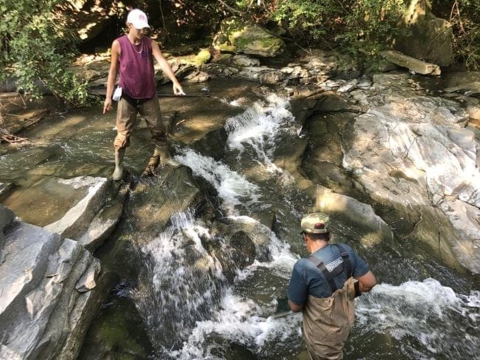It’s a hot and humid central Georgia morning when I meet up with U.S. Fish and Wildlife Service (Service) Biologist Tamara Johnson at a library parking lot in Northwest Atlanta. Today’s mission is to survey Proctor Creek, an urban watershed, for aquatic wildlife. As anyone who’s embarked on a large project knows, it takes a village. Tamara’s village includes fellow Service biologists, interns, graduate students, and members of the community surrounding Proctor Creek. Together, they’ve been surveying the stream all summer. (If you’ve experienced Georgia heat you know that’s no easy feat while wearing waders.)
Before we depart for the creek we must first circle up and take part in a group tradition of going around and stating what each person would be as a random object. Today is “What item off the McDonald’s menu would you be?” After a lot of laughs and bonding over fast food we head for Proctor Creek. Within 10 minutes we arrive at our first location next to a pet cemetery.
Upon entering Proctor Creek, it’s easy to forget that you’re in the heart of metropolitan Atlanta. There’s a stillness that only nature can provide, and the flowing stream is a peaceful break from the sounds of city life. “We’re here to show folks that there’s life in Proctor Creek. That even in urban settings there is nature and wildlife that needs protecting,” Johnson said.
For about 30 minutes the team surveys upstream, with half using a large net (seine), and the rest using smaller individual nets (dip nets). There’s not a lot of information about the aquatic inhabitants in the Creek, so every specimen that’s caught is gently put into a bucket and recorded at the end. The first site rewards our efforts as we uncover a few small fish and tiny crayfish.
Once the data is recorded we’re on to the next site, and it’s truly a sight to behold. Surrounded by a canopy of trees and water rushing over small rock waterfalls, for a brief moment I’m certain I’ve been transported to The Jungle Book. I walk over to Juanita Wallace, one of the community volunteers who grew up near Proctor Creek as she’s skimming the water with a small net.
“When I was a kid we would come and swim at Proctor Creek, and we would easily catch crayfish to eat,” Mrs. Wallace said. Moving back to Atlanta as an adult she was shocked to see how much Proctor Creek had changed over the years due to pollution, which prompted her to join community efforts to restore it.
We make our way to the third and final site of the day. It’s getting closer to midday, and the heat is becoming more apparent. Thankfully, this site is also nicely shaded. Watching as the team measures a vibrantly colored sunfish, it drives the purpose why we’re here and the value in working to restore this watershed is driven home. There is indeed life in Proctor Creek. The fish and other aquatic species are not the only ones who have benefited from the team’s survey work this summer.
“Connecting with the Proctor Creek community humbled me as a scientist,” Johnson said. “Riding around with Ms. Juanita Wallace all summer taught me about the deep history of the area including roots of the civil rights movements and historical figures like Martin Luther King, Jr. and Maynard Jackson. She also painted a picture of a vibrant, thriving community through her anecdotes of playing in the creeks and woods of the west Atlanta community as a child. These stories enriched every site we surveyed, and it broadened the idea that there is life in Proctor Creek beyond the aquatic species we were catching.”







